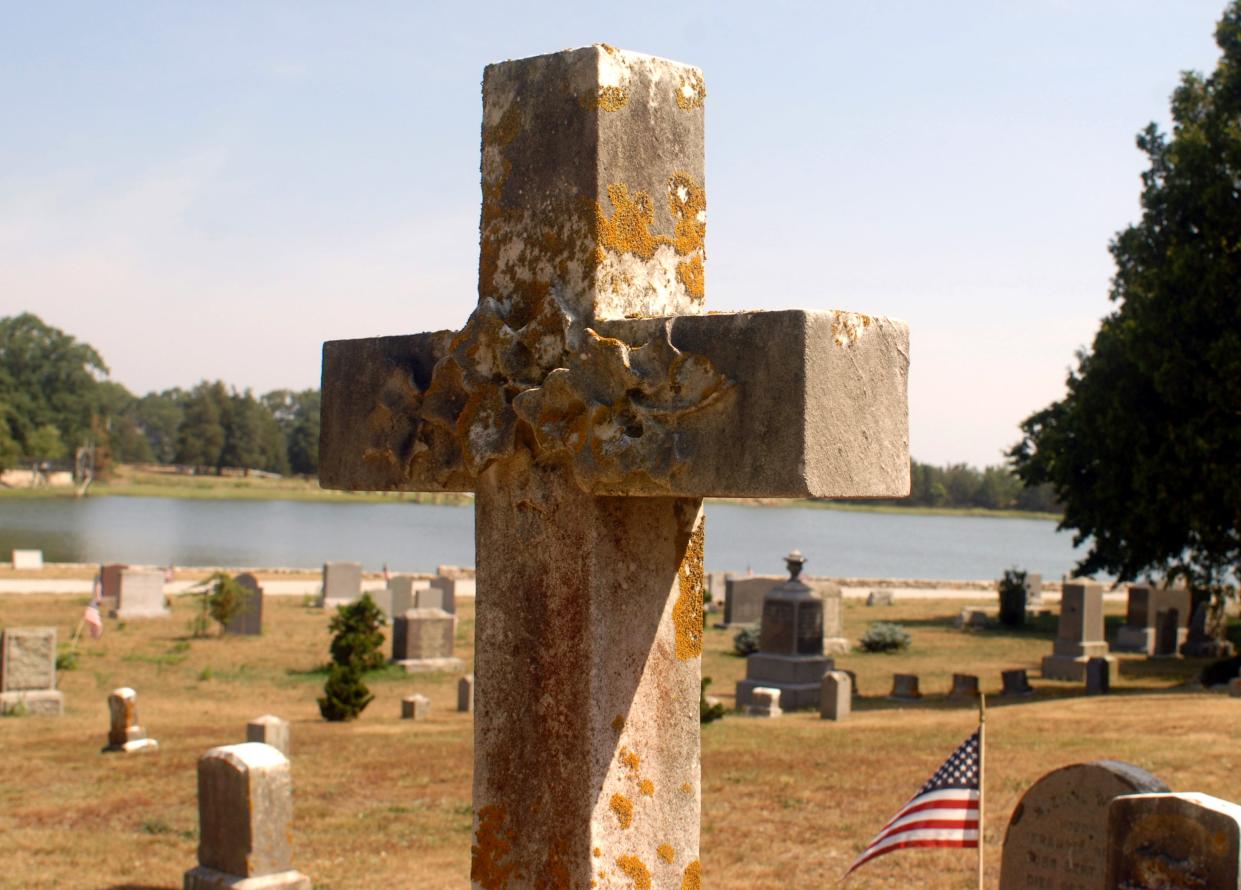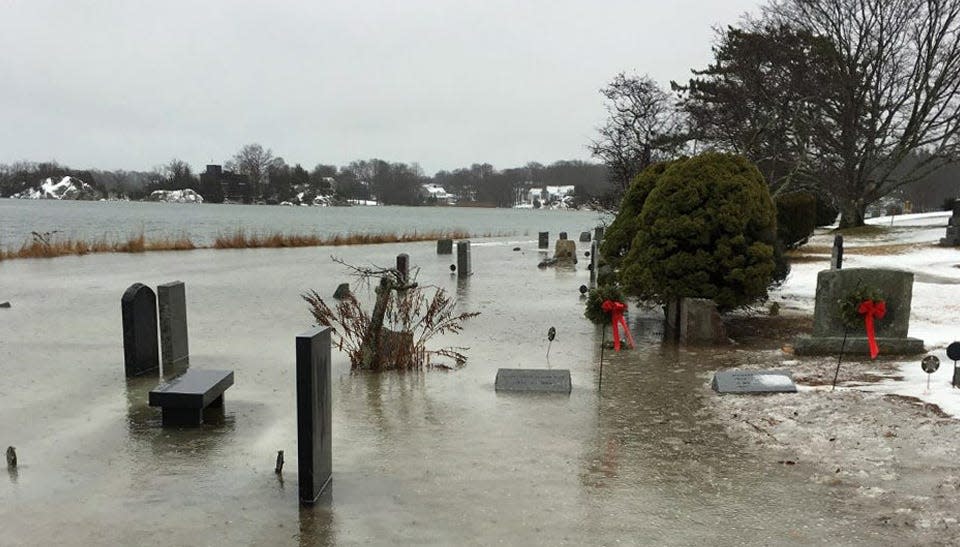Boston Tea Party rebels and shipwrecked souls rest here. The ocean had other ideas, though.

COHASSET, Massachusetts — Above a shimmering green harbor glazed by the hot sun, a sculpted ship's anchor wrapped in a chain rises up out of an old gravestone.
When the season turns cold, silvery winds come in harsh over gunmetal gray water and sweep over the haunting ornament, a reminder of a long-gone soul once tied to the sea.
Like the imagery on this single stone, the entire cemetery is chained, bound to the ocean’s whim. Rising sea levels may not have impacted them in life, but inhabitants of Cohasset Central Cemetery were slipping underwater in death.
An only son who died of an overdose. World War II Navy officers. Markers for men who never came back from Vietnam.
For years, the water had been creeping up, with arms outstretched, trying to reclaim land. The tide careened around the gravestones, enveloping them and seizing new ground every year. When it retreated, their carefully chiseled inscriptions were encrusted with salt.
Located in a seaside village rooted in fishing and shipbuilding, Cohasset Central Cemetery in Massachusetts is one of countless places along the Atlantic seaboard where history and lineage are being claimed by the ocean, rivers and the consequences of extreme rainfall. New England is experiencing temperature warming and sea-level rise at a rate faster than the rest of the nation.
Flooding used to leave the ground around the gravestones sodden in seawater, seeping through dirt and root systems down into the dark earth to caskets and urns. The stones’ firm placement in the soil eroded.
Mary Nisula watched helplessly as her family’s plot flooded regularly, the same place she’ll be buried one day next to her son, parents and sister, all of whom died before her.
“I just wished I was in my urn so when the waves took the rest of them out, they took me, too,” she said.
It took a gargantuan effort on the part of the cemetery’s board of directors, but the march of floodwater from nearby Little Harbor has since been halted. But as to whether it will hold, only the ocean has a say.

Connections to ancestry, culture and stories of the past, cemeteries are evidence of people — of lives lived. At stake is the erasure of history, family and legacy in the markers and remains disrupted by nature's changing forces.
For thousands of years, humans have used burials to guide the deceased into whatever comes next. What happens when sacred history is disrupted?
On the East Coast, where coastal flooding occurs the most frequently in America, the number of flood days is increasing, according to the Environmental Protection Agency. It will keep increasing.
'I reckon I have more ancestors here than anyone else’
The cemetery sprawls down a curving side street in Cohasset, once the fourth-largest fishing port in Massachusetts. At the four-acre setting stippled with gravestones, fir trees define an expanse of weathered shingles, mowed lawns and pink dogwood trees.
The landscape is archetypal of old coastal New England. The pewter-colored and spectral cemetery flanked by detailed iron gates is on the National Register of Historic Places.
On humid days, the distance of time and space echoes in Cohasset Central Cemetery. The splatter of cool December water as tea plunged into Boston Harbor, and musket fire from Revolutionary War soldiers.
Up the cemetery’s wooded slope, farmers, seafarers and shipbuilders are marked by slate, marble and granite. Under a towering Celtic cross are more than 40 Irish immigrants who died on a shipwrecked Brig St. John fleeing the potato famine in 1849. There are friends of Henry David Thoreau. A famous pre-Vaudeville acrobat.
Overlooking the graveyard, Suzanne and Ed Wadsworth live in an old, well-kept home. A couple in their 70s and 80s, they both serve on the board of directors.
For them, the flooding threatened sanctified grounds where about 60 of Ed’s relatives are buried. Among them is the couple’s son.
“I reckon I have more ancestors here than anyone else,” Ed Wadsworth said.
Lichen the color of burnt orange and seafoam green has overtaken stones and monuments, crawling through the crevices of winged skulls and weeping willows. A stamp of time.
In the cemetery, there are 135 members of the Bates family and 110 of the Towers. Stones are carved with names like Lucretia, Ibrook, Obadiah and Sophronia. Horace, Ignatius, Gussie.
One of the most famous Towers was Boston Tea Party rebel Abraham Tower. He’s joined in the cemetery by his tea party compatriot James Stoddard II and also The Rev. John Browne, known for storing rebel guns under his church pulpit during the Revolutionary War.
Bethiah Nichols Tower, nicknamed “Resolution Tower,” carted water barrels from a nearby pond to water the cornfields during a summer drought when men were away fighting the Revolution. Her daughter allegedly rowed a boat from Cohasset to Gloucester to get food and supplies, skirting enemy ships along the way.
They both lie in Cohasset Central Cemetery.
Rick Towle, president of the cemetery’s board of directors, is a sixth-generation Cohasset resident, and four generations of his family are buried there. His father and grandfather.

“We are custodians,” he said. “You have to do everything you can to maintain it.”
During the winter of 2018, an intense nor'easter flooded more than 100 graves with icy water — the most striking intrusion yet by the cemetery’s increasingly temperamental neighbor. Sharing a border for more than 300 years, Little Harbor had become its biggest threat.
Suddenly, “rest in peace” and “final resting place” seemed uncertain when graves were at risk of desecration and those that lie beneath them in danger of being unearthed.
Cemetery flooding: Climate change doesn’t spare the dead
The history inside Cohasset Central Cemetery’s iron gates is humbling, in ways cardinal to chapters of Massachusetts’ past. Flooding threatened its overall landscape, and directly, dozens of gravesites.
Concerns from loved ones mounted as the ocean’s appetite grew bigger each year. Even normal high tides began to reach the graves, and when storms turned especially voracious, an entire section of the cemetery was underwater.
Thick slush and sheets of translucent ice floated on top of gravesites in an area where many war veterans are buried.
Mary Nisula’s family plot is one of the closest to the water, where her parents, sister and son are all buried next to each other under flat stones. She’d worked hard to let go of feelings attached to the flooding, the sight of her son’s name, Philip Chesarone, underneath murky ocean water.

He was just 23 years old in 2008 when he mixed opioids and alcohol after a bicycle accident and never woke up.
Nisula said he loved skateboarding, music and animals.
“We were very, very bonded,” Nisula said. “I think he thought I was the only person in the world that loved him."
She could attend meetings related to sea-level rise and climate change, but she felt useless over “the sad fact that my family is going to end up in Little Harbor.”
Nisula told herself: “I’m not powerful enough to stop this.”
In a way, coming to terms with it felt like giving up.
Graveyards across the country are facing similar plights. In 2011, Hurricane Irene ripped open a mountainside cemetery in Vermont, scattering human remains downriver. Some were old bones difficult to identify, while others were recent burials, causing excruciating pain for family members.
Louisiana in 2018 developed a formal statewide response because of how regularly it sees floating caskets and tombs during and after hurricanes.
A historic Black graveyard in Annapolis, Maryland, contains the remains of 7,000 enslaved and freed African Americans who weren’t allowed to be buried next to white people. Descendants fear erasure of their past, because the burial ground is plagued by flooding and erosion as rainfall grows more intense.
Kate Willis, architectural historian and project manager at Kleinfelder, an engineering, science and architecture consulting firm, emphasized the importance of learning about and preserving “non-white, non-European, non-male" historic resources.
On Cape Cod, for example, not far from Cohasset, erosion this year uncovered a fully intact 1,000-year-old skeleton in a Wampanoag grave.
Raising the gravestones and building a seawall
The board of directors at Cohasset Central Cemetery found themselves in a privileged position to do something in response, as an active group of nonprofit status with money and familial stake.
They had resources to combat the rising sea. A substantial financial endowment that began with a gift in the 1970s; one that continued to grow through fundraising efforts over the years.
To protect the legacies and ancestral ties made fragile by a changing sea, they decided it was their duty to use it, to throw what they could at the crisis. They would add new ground on top of the affected burials and raise the headstones. Then they’d build a wall to protect them.
Forming a flood mitigation committee chaired by Ed Wadsworth, the board of directors consulted a local engineer. Scientific estimates were given and a contractor and mason were brought in to elevate the gravestones and build a 390-foot seawall.

The deceased were never moved or disturbed. They’re not six feet under anymore, but “10 feet under,” Suzanne Wadsworth tells people when she explains what they did.
The exact locations of the burials underground were digitally mapped, and then new fill was added on top of the existing ground level. The headstones were elevated on top of the new surface, in their exact location as before.
The seawall was finished in 2020, built to provide flood protection for 30 years, based on predictions.
With stones stacked together like tidy puzzle pieces, the wall now curves around the cemetery’s fringe as a barrier from Little Harbor. It appears timeless, natural. Perhaps like it was always there. Wadsworth said she knew they did right by history when down by the wall one day, a pedestrian asked her when were they starting the flooding project?
She smiled. It had been completed for months.
But Little Harbor is still changing. Coiling beneath the surface, the ocean itself is expanding as temperatures warm. And hundreds of miles away, glaciers and ice sheets in Greenland and Antarctica continue to melt. Cohasset Central Cemetery is protected — for now.
Up and down the East Coast, impossible decisions are being made. What do we save? What do we let go? Are mitigation efforts a match for the forces building in the atmosphere?
“I see it as solving a problem for the moment,” Nisula said. “I don’t know what will happen in the future, and I can’t even go there.”
This article is part of a USA TODAY Network reporting project called "Perilous Course," a collaborative examination of how people up and down the East Coast are grappling with the climate crisis. Journalists from more than 35 newsrooms from New Hampshire to Florida are speaking with regular people about real-life impacts, digging into the science and investigating government response, or lack of it.
This article originally appeared on USA TODAY NETWORK: Climate change and the ocean threaten to unearth centuries-old graves

